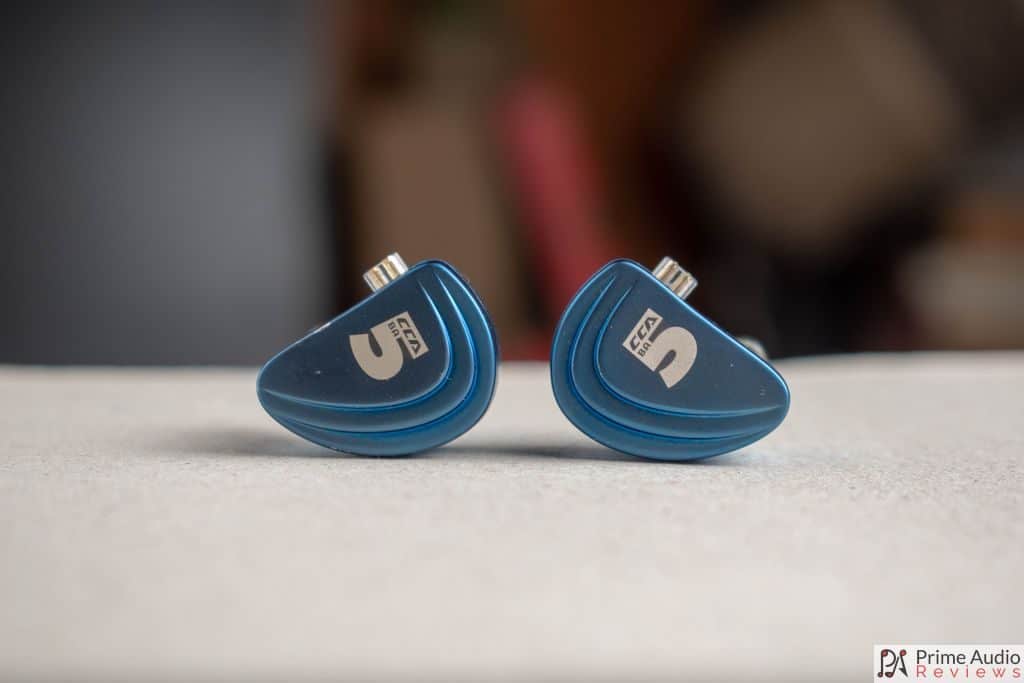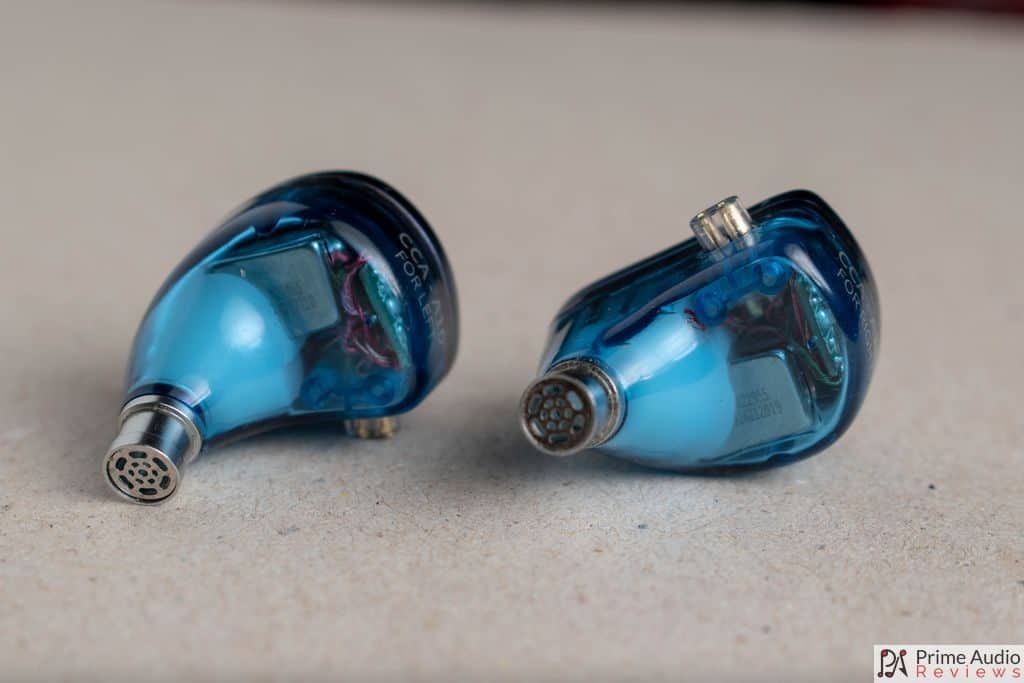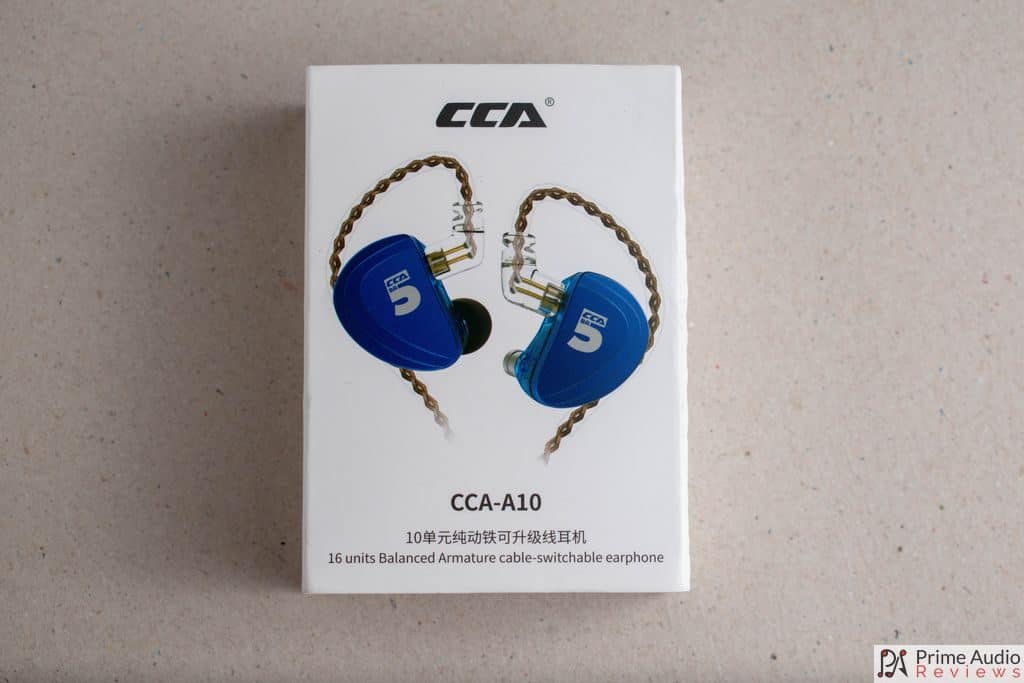Today we have a review of the CCA A10, an earphone with 5 balanced armature drivers per side and a resin acoustic chamber within its shells. At the time of writing, the A10 is available from as low as $41. If at a glance this IEM looks familiar, well, there’s a very good reason for that. Read on to find out why.
This sample was provided for the purpose of an honest review. All observations and opinions here are my own based on my experience with the product.
- Good build quality and comfort
- Clarity and detail
- Tight, fast bass
- Unoriginal design (uses same shells as several other models)
- Harsh upper midrange/lower treble
- Meagre accessories
Package and Accessories
The packaging for the A10 is essentially the same as the CCA C10 and C16 plus the smaller type KZ (and now Tripowin) boxes. The box is white with a clear, coloured image of the earphones on the front. On the rear of the box is some company information and a list of specifications.
Upon opening the box you’re greeted with the in-ears which are seated in a foam insert. The cable and other accessories are placed beneath the insert. The bundle follows the same, basic formula as the other brands in this extended nuclear IEM family and contains the following:
- CCA A10 earphones
- Detachable 2-pin cable
- 3 pairs of silicone eartips
- User guide/warranty
Build Quality and Design
Physically, the A10 is practically identical to the KZ AS16 and Tripowin TP10 apart from differing faceplate designs. A10’s faceplates are a deep blue colour with a large #5 in white print and a textured ripple design towards the back edge.

The shells are transparent blue acrylic which let you see inside what is becoming a familiar sight of the 3D white acoustic chamber with sound tubes beneath the nozzle. You can also see the tidy internal layout of the balanced armature drivers and wiring.
A single tiny vent can be found on the inner side of the shell. The nozzle is aluminium and has a proper ridge to ensure your eartips stay securely in place. Covering the nozzle opening is the same metal grill with a flowery pattern that we saw on the KZ AS16.

Comfort and Noise Isolation
The A10 has comfortable housings, although they are quite large and may be problematic for people with small ears. Edges are rounded and the shells are smooth with a curved surface. I can wear these for long periods of time without any issues.
Noise isolation is above average, making this a good choice for commuting and noisy environments. There is almost no noise leak at all so you won’t disturb others around you with your music.
Cable
The included cable is the standard KZ brown copper version with pre-formed ear guides. At the top are the socketed 2-pin connectors in a transparent plastic housing. After the pre-formed ear guides, you’ll come to a chunky rubber Y-split which is placed way down the cable and is on a mission to make your cable a tangled mess at every opportunity. The cable terminates in a right-angled rubber 3.5 mm plug. Overall, it’s a decent quality cable and one we’re very familiar with.

Sound
Gear used for testing includes the FiiO M6 and iBasso DX120 as portable sources. On the desktop, I plugged the earphones into the xDuoo XD10 Poke USB DAC/Amplifier. The A10 does not need extra amplification and can easily be driven straight from a smartphone or low-powered device.
The CCA A10 has a bright sound signature that focuses heavily on the upper midrange and lower treble. It has a light bass, good clarity and plenty of detail.

Bass
The bass is fast and agile, with a clean slam. Sub-bass quantity is very light and does not have much in the way of rumble. The mid-bass has a more natural weight but also lacks emphasis which gives the overall tonality a leanness and not much in the way of body.
Mids
The A10’s midrange is very clean with abundant clarity and a good amount of detail. However, midrange notes are very lean, lack body and as a result, their tone sounds slightly off. The upper midrange is very forward, making vocals clear and articulated but they can become harsh very quickly at anything above very low volume.
Treble
Following the momentum of the upper midrange, the A10’s treble also comes well forward. With its extra light bass, there’s nothing to counterbalance the brightness of the treble which makes it come across as splashy and overly aggressive. This makes it fatiguing and shrill even if it does add detail and air.
Soundstage
The soundstage has moderate dimensions and is fairly evenly distributed between width and depth. Vocals are quite intimate and the stage is forward, putting the listener in or near the front row. Instrument separation is good but there’s not much in the way of layering and imaging is vague.
Comparisons

Tripowin TP10
This is a super easy comparison because, for all intents and purposes, the TP10 is exactly the same as the A10. Apart from some minor differences on the faceplates, these 2 IEMs are physically identical. from the internal acoustic chamber and positioning of the 5 BA drivers to the exact same shade of blue used for the shells, they are the same.
On top of that, they measure and subsequently, sound identical too. They are both around the same price, although the A10 can often be found on sale for less.
KZ AS16
Notice anything familiar? Yes, that’s right. The CCA A10 shares the same shell as the KZ AS16. Once again we see a slight variation of the faceplate design and identical shells but this time there are some differences internally as well. This is because the AS16 has an extra 3 BA drivers packed in each side.
That’s about where the differences end because the A10 and AS16 sound almost the same. The AS16 is a hint less bright and its midrange sounds a touch more natural but that’s about it. And what does the AS16’s extra refinement cost you? Around $84 more.
CCA C16
While we’re here we should take a look at the C16 as well. This one uses the same faceplate but has a slight variation in the shell. It’s opaque this time and it has a nozzle formed from the same single piece of acrylic, rather than the aluminium ones on the A10. Additionally, the C16 has conventional 2-pin sockets instead of the socketed type found on the A10.
There are more significant differences in sound this time around. The C16 has a fuller midrange with extra body and a more natural timbre. It is also smoother and less peaky in the treble. It will, however, cost you around $50 more than the A10.

Conclusion
The CCA A10 is bright and detailed with a light and nimble bass. Considering it shares an identical body and near identical sound to the much more expensive KZ AS16, some might see it as a real bargain. To my ears, however, there are many alternatives at the same price or less that offer better audio quality and some originality.
Specifications
- Impedance: 15Ω
- Earphone sensitivity: 98db/mW
- Frequency range: 20-40000Hz
- Cable Interface: 3.5mm
- Cable Length: 1.2m±5cm
- Earphone Interface Type: 2 Pin 0.75mm interface
- Driver: 5BA, 22955*1, 29689*2, 30095*2







